Culture statistics - household expenditure on culture
Data extracted in May 2023.
Planned article update: December 2024.
Highlights
In 2020, 2.6 % of total consumption expenditure by EU households went to culture-related goods and services.
In 2020, households in the EU spent 26.9 % of their total cultural expenditure on information processing and 25.1 % on books and newspapers.
This article forms part of the online publicationCulture statistics. It provides an overview of key figures on household consumption expenditure on culture-related goods and services. The data are collected through the household budget survey (HBS), a national survey carried out by EU Member States collecting data primarily on households' consumption expenditure on goods and services.
Full article
Household expenditure on cultural goods and services – scope and level
Within household expenditure, the aggregate covering cultural goods and services is based on the classification of individual consumption by purpose (COICOP) and comprises 14 different items grouped into the following five broad categories of cultural expenditure:
- equipment (portable devices, information processing equipment and equipment for the reception, reproduction and recording of vision, sound and recording media (CDs, DVDs, Blu-ray disks, vinyl records, etc.);
- books and newspapers;
- fees and subscriptions (broadcasters' fees and subscriptions, including TV on demand, cable and paid TV, as well as various streaming services that enable the reception of audio and video content; this also includes hiring prices for equipment and accessories for cultural purposes);
- attendance and entertainment (cinemas, theatres, museums, libraries, concerts and services of photographers and performing artists);
- articles for artistic expression and creation (including cameras, video cameras, musical instruments, stationery and drawing materials).
2.6 % of total household consumption expenditure in the EU was spent on cultural goods and services.
According to the latest HBS data, in 2020 private households in the European Union (EU) spent, on average, an estimated 2.6 % of their total expenditure on cultural goods and services (see Figure 1).
The share of culture-related expenditure in total household consumption spending varied considerably across the EU Member States. Several factors might impact this share, including household income, price levels, the ease of access to cultural venues, national cultural policies, and habits. In 2020, 8 countries recorded a share of cultural expenditure in total household budgets above the average among the 22 EU Member States with available data. The highest percentage of the household budget spent on cultural purposes was in Denmark (3.9 %). By contrast, in 13 countries the share was below the EU average, with the smallest share in Greece (1.3 %).
Figure 1 also shows the average level of household expenditure on cultural goods and services, measured in purchasing power standards (PPS), an artificial currency unit that takes account of the price-level differences between EU Member States. In 2020, Austria, Germany, Denmark and the Netherlands had the highest levels of expenditure on cultural goods and services, on average, more than 1 000 PPS yearly. Lowest shares with less than 300 PPS were recorded in Greece, Slovakia, Lithuania and Bulgaria.
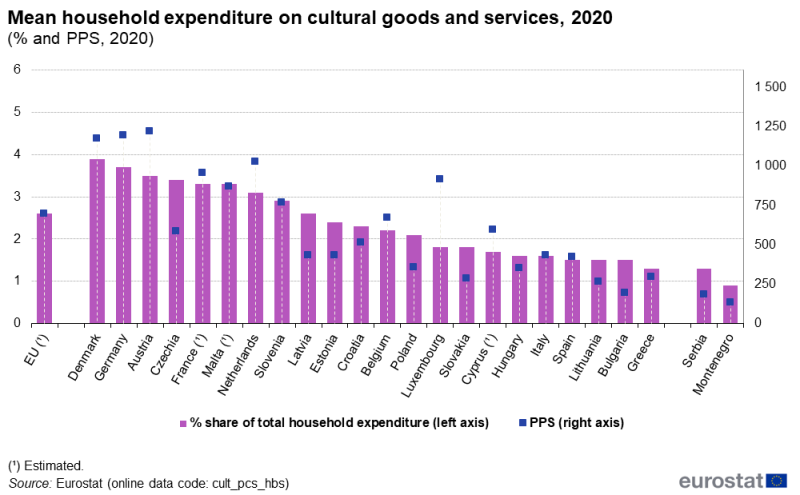
Source: Eurostat (cult_pcs_hbs)
All countries that spent more than 50 % of total expenditure on food and housing, spent less than 2.5 % on culture.
At EU level in 2020, 2.6 % of household expenditure was spent on culture, while 48.5 % went on food and housing. Figure 2 shows an inverse relationship between essential goods and cultural expenditure: the higher the percentage spent on food and housing, the lower the percentage for cultural expenditure (the vertical axis represents cultural expenses as a percentage of the total households expenditure, while the horizontal axis represents the percentage spent on food and housing). In all countries where food and housing accounted for more than 50 % of total, less than 2.5 % was spent on culture.
Furthermore, in Figure 2, the size of the circles represents the ratio between the two categories of expenditure: the bigger the circle, the larger the gap between cultural expenditure and food and housing. At EU level, spending on food and housing was about 19 times higher than on culture, with considerable differences between countries. Notably, in Malta, Austria and Germany, essential spending was 9 to 11 times cultural spending; while in Greece and Hungary households spent over 40 times as much on food and housing as on culture.
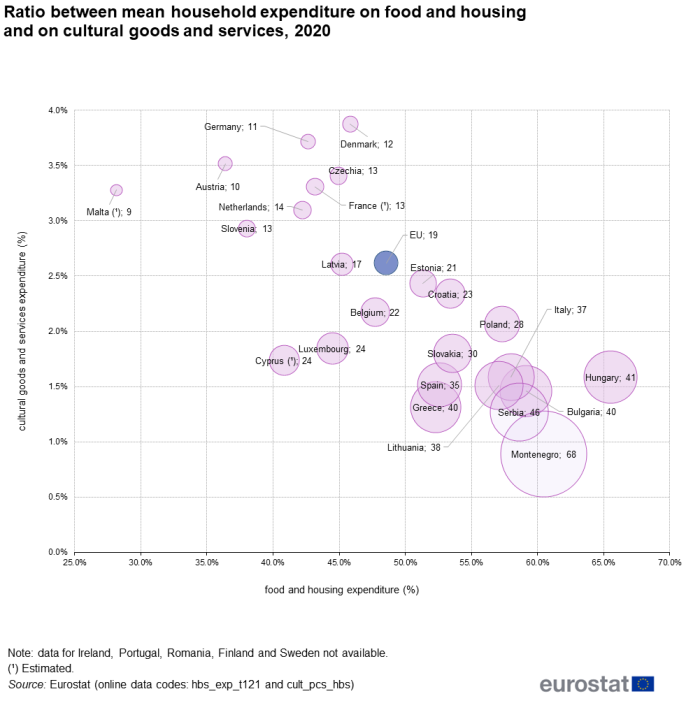
(% and ratio)
Source: Eurostat (hbs_exp_t121) and (cult_pcs_hbs)
On average, EU households allocated about a quarter of their cultural expenditure to books and newspapers and another quarter to information processing and audio-video equipment.
In 2020, on average 26.9 % of EU household cultural expenditure went on information processing, audio-video equipment and recording media, 25.1 % on books and newspapers, 20.8 % on broadcasters' fees and hiring of equipment and accessories for culture and 13.7 % on attendance and entertainment, leaving the remaining 13.5 % for articles of artistic expression and creation.
Figure 3 shows the structure of household expenditure on culture from the 2015 and 2020 HBSs. Expenditure shares for books and newspapers and attendance and entertainment remained relatively stable between the two surveys. Compared with the 2015 survey, in 2020 a higher share of expenditure went on equipment and articles for artistic expression and creation, while a smaller portion was spent on fees and subscriptions.
The 2020 round of the HBS took place during the COVID-19 pandemic for many countries. Due to the specific circumstances related to the crisis, the fieldwork was altered and changes had to be made to the usual methods of data collection, and thus caution is needed when comparing 2015 with 2020 figures. For more details, please refer to the 'Data sources and methodology' section of this article.

(%, share of all household cultural expenditure)
Source: Eurostat (cult_pcs_hbs)
The structure of household expenditure across the five categories showed in Figure 3 at EU level varied significantly between countries. Figure 4 shows the diverse nature of cultural spending across the EU Member States for the five aggregates.
- Information processing equipment, audio-video equipment and recorded media accounted for the largest part of the households' cultural spending in 13 EU countries. The highest percentage was in Lithuania and Spain (both at 45 %), while the lowest was in Slovenia (18 %).
- Household expenditure on books and newspapers ranged from 16 % in Slovakia to 37 % in Italy. In Italy and Germany, these products represented the largest part of total culture-related expenditure.
- In 8 countries fees and subscriptions represented the largest part of expenditure on cultural goods and services. The lowest share for fees and subscriptions was observed in Spain (3 %), while the highest was in Bulgaria (41 %).
- Attendance and entertainment accounted for more than a fifth of household cultural budgets in Latvia (30 %), Estonia (24 %), and Cyprus (21 %). This category had the lowest impact on household culture-related expenditure in Hungary (7 %) and Poland (5 %).
- Expenditure on articles for artistic expression and creation accounted for approximately one fifth of households' cultural budgets in Belgium and Poland. The smallest share of culture-related household budgets was allocated for this purpose in Denmark (4 %).
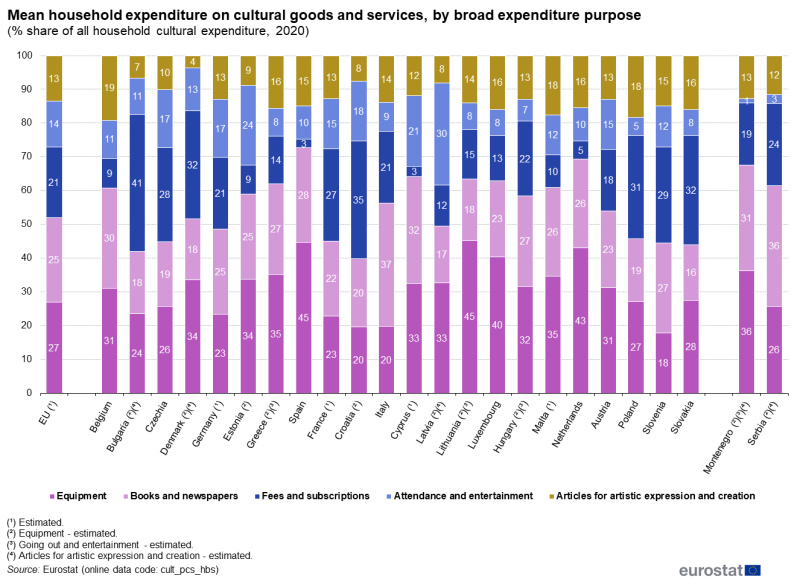
(%, share of all household cultural expenditure)
Source: Eurostat (cult_pcs_hbs)
Table 1 analyses the structure of cultural expenditure in the EU, providing information about all 14 cultural items that comprise mean household expenditure on cultural goods and services. This level of granularity shows that the largest proportion of EU households' expenditure on cultural goods and services in 2020 went on television and radio broadcasting fees, hiring fees for equipment and accessories for culture (20.8 %), followed by newspapers and magazines (12.6 %), information processing equipment (12.5 %), and books (12.5 %). Conversely, the smallest shares of household expenditure on cultural goods and services were for photographic and cinematographic equipment (1.7 %) and the repair of audiovisual, photographic, and information processing equipment (0.6 %).
In 2020, the shares of the different expenditure categories varied greatly across the EU countries. Newspapers and periodicals ranged from 6.6 % of households' cultural budgets in Spain and Croatia to 16.3 % in the Netherlands. Equipment for the reception, recording, and reproduction of sound, vision, and picture ranged from 5.4 % in Slovenia to 15.6 % in Cyprus.
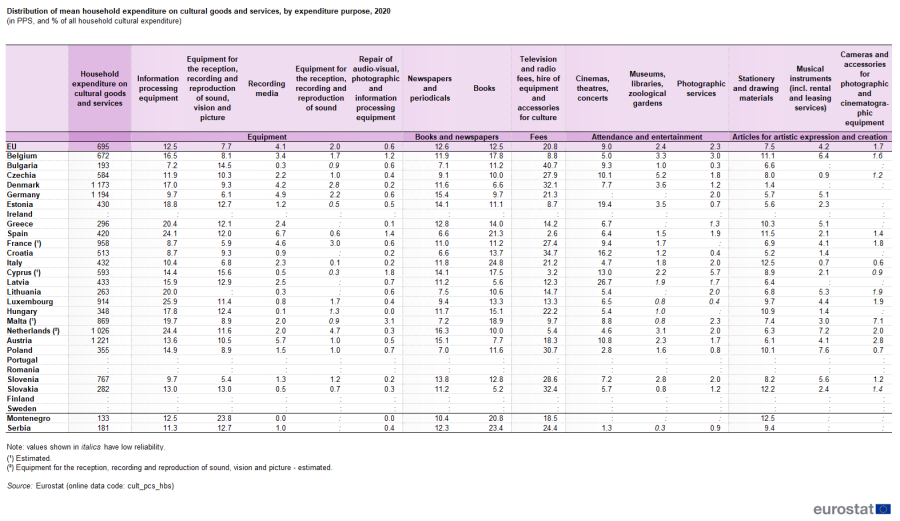
(%, share of all household cultural expenditure)
Source: Eurostat (cult_pcs_hbs)
Household cultural expenditure - impact of household income
EU mean household expenditure on cultural goods and services was greatly influenced by income levels.
In 2020, household expenditure on cultural goods and services varied significantly across the income distribution, showing a strong income dependency.
As shown in Figure 5, increases in spending on culture-related purposes were the most pronounced between households in the fourth and fifth income quintile. In 10 out of 20 EU countries with available data, households belonging to the fifth quintile spent at least 1.5 times as much as households from the fourth quintile.
The highest to lowest quintile ratio measures the difference in culture-related expenditure between income groups. With the exception of one country, the mean consumption expenditure for households in the fifth quintile was at least three times higher that of households in the first income quintile, indicating sharp inequalities in cultural spending due to income.
The most notable disparities in household expenditure on cultural goods and services across different income quintiles were observed in Cyprus. As shown by the highest-to-lowest income quintile ratio, for households in the fifth quintile, culture-related expenditure was nine times higher than that in the first quintile (1226 PPS vs 133 PPS). Significant disparities in culture-related expenditure based on household income were also present in Spain and Latvia, where households in the highest income group spent around five times as much on culture as those in the lowest income group.
By contrast, the least variation in household cultural expenditure between different income quintiles was observed in Slovakia, where spending on culture-related purposes was nearly equal between income quintiles, and where households with the highest income spent for culture-related purposes only twice as much as households with the lowest income (375 PPS vs 178 PPS).
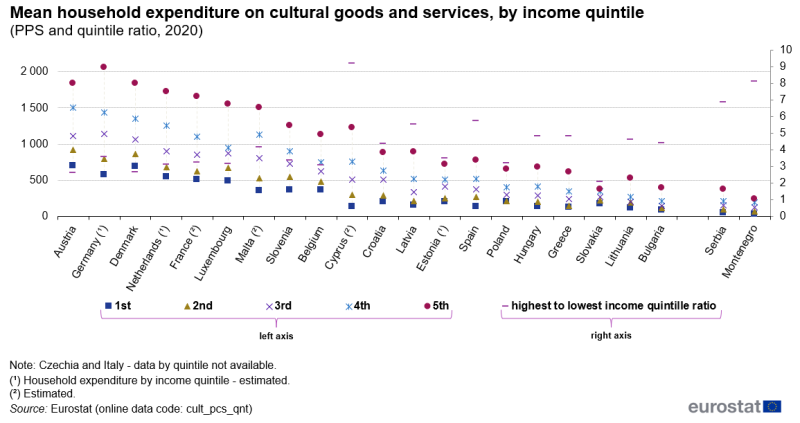
(in PPS – left axis; highest to lowest quintile ratio – right axis)
Source: Eurostat (cult_pcs_qnt)
Data sources and methodology
Eurostat compiles data on cultural expenditure from the household budget survey (HBS).
Household consumption expenditure on cultural goods and services reflects the level of cultural participation and may be influenced by a range of factors, including household composition, age, wealth/income, the availability of cultural facilities and price structures. Data on household consumption expenditure are available in national currencies, euro and PPS; the latter are used to eliminate price-level differences between countries. The use of data in PPS terms ensures that information is valued at a uniform price level and therefore reflects only volume differences in the economy, as opposed to price-level differences. As an example of the order of magnitude of the PPS, data on on mean consumption expenditure per household and per adult equivalent, are available in different units of measure, including PPS, national currency and euro, which can be compared by country.
Data are collected using national surveys in each participating country. The collection involves a combination of one or more interviews and diaries or logs maintained by households and/or individuals, generally on a daily basis (recording their consumption over time). The HBS is carried out approximately every 5 years, the most recent referring to 2020. The fieldwork for the 2020 HBS data collection took place between 2018 and 2022 for the majority of EU Member States, with the exceptions of Cyprus, Malta and France, where data were collected between 2015 and 2017. Data for these countries have been produced by converting 2015 to 2020 reference year prices using the 2020 HICP coefficient. For Finland, Ireland, Portugal and Sweden, data for the 2020 wave were not available at the time of writing. For Romania, data for the categories on cultural goods and services were not available. The data collection and expenditure patterns of households in some EU Member States could have been affected by the COVID-19 pandemic and related restrictions.
The classification of individual consumption by purpose (COICOP) is a classification developed by the United Nations Statistics Division to classify and analyse individual consumption expenditure incurred by households, non-profit institutions serving households and general government, according to their purpose. The European version of this classification – ECOICOP — is extended to 5-digits in response to the need for more detailed data on household budgets and consumer price indices.
Data on household expenditure can be used to analyse expenditure patterns of specific types of household or expenditure patterns for particular groups of goods and services (such as cultural items, as covered in this article). This information is mainly used at EU level in connection with consumer protection policy. HBS statistics have also been used in conjunction with information on Consumer prices of cultural goods and services to develop a consumer market scoreboard that tracks how markets in various sectors of the economy have been performing from a consumer's perspective.
The HBS uses the COICOP classification. Culture-related goods and services within COICOP cover cultural goods such as books and newspapers, the manufacture of various articles that enable artistic creation (for example, musical instruments, photo and video cameras or drawing materials) or the equipment for the consumption of various forms of culture (TV and stereo equipment, information and communication technologies, as well as the actual media on which some cultural products can be delivered (CDs, DVDs or Blu-ray).
In an ESSnet-Culture final report (2012), the following COICOP items were identified as relating to culture (for the consumption expenditure of households):
- books;
- newspapers and periodicals;
- cinemas, theatres and concerts;
- museum, libraries and zoological gardens;
- musical instruments;
- cameras and accessories for photographic and cinematographic equipment;
- stationery and drawing materials;
- services of photographers and performing artists;
- television and radio fees, hire of equipment and accessories for culture;
- information processing equipment;
- reception, recording and reproduction of sound and vision;
- recording media;
- reception, recording and reproduction of sound;
- repair of audiovisual, photographic and information processing equipment.
For the purpose of this article, the concept of household expenditure on cultural goods and services comprises the ECOICOP categories listed in Table 2.
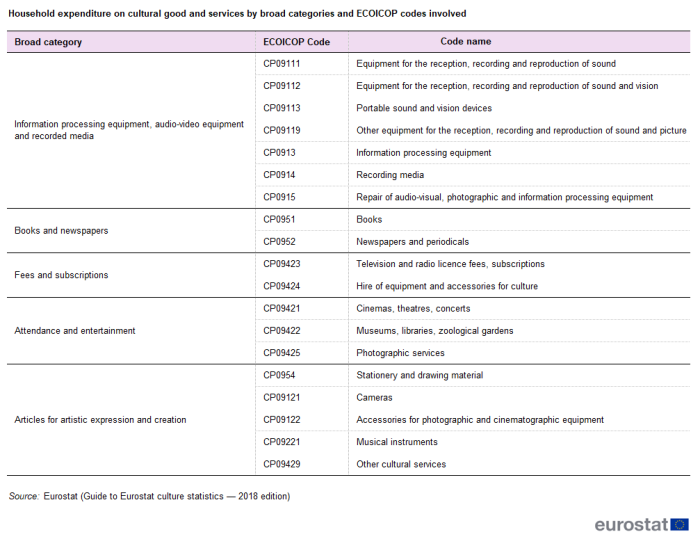
Source: Eurostat (Guide to Eurostat culture statistics – 2018 edition)
Context
Culture is one of Europe's greatest assets: it is a source of values and identity and creates a sense of belonging. It also contributes to wellbeing, social cohesion and inclusion. The cultural and creative sectors can trigger economic growth, job creation and international trade.
The EU supports these objectives through the Creative Europe programme and several policy actions included in the Work Plan for Culture (2023-2026). The plan, adopted by the Council of Culture Ministers of the EU, sets out the current main priorities for European cooperation in cultural policymaking: empowering the cultural and creative sectors, enhancing cultural participation and the role of culture in society, unleashing the power of culture and strengthening the cultural dimension of EU external relations. The implementation of the Work Plan for Culture (2023-2026) is supported by optimised use of quality data and statistics.
Direct access to
- Culture (cult), see:
- Private households expenditure on culture (cult_exp)
- Mean consumption expenditure of private households on cultural goods and services by COICOP consumption purpose (cult_pcs_hbs)
- Mean consumption expenditure of private households on cultural goods and services by income quintile (cult_pcs_qnt)
- Mean consumption expenditure per household by COICOP consumption purpose (hbs_exp_t121)
- European statistical system network on culture (ESSnet-Culture final report (2012))
- Private households expenditure on culture (ESMS metadata file — cult_exp_esms)
- Consumption expenditure of private households (ESMS metadata file — hbs_esms)
- Description of data transmission for HBS (Reference Year 2020)
- Household Budget Surveys (HBSs)
- Regulation (EU) 2021/818 of the European Parliament and of the Council of 20 May 2021 establishing the Creative Europe Programme (2021 to 2027) and repealing Regulation (EU) No 1295/2013
- Regulation (EC) No 2019/1700 establishing a common framework for European statistics relating to persons and households, based on data at individual level collected from samples
- European Council Work Plan for Culture (2023-2026)
- European Council Work Plan for Culture (2019-2022)
- European Council Work Plan for Culture (2015-2018)